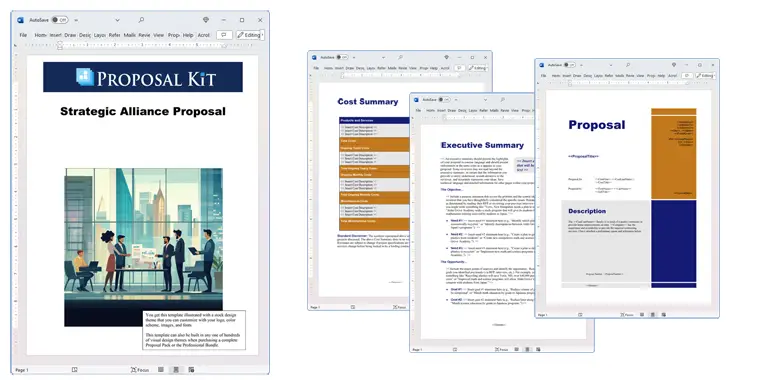How to write your Strategic Alliance Proposal
We include this 23 page layout with every Proposal Pack. If you want this template to have a different visual design theme than the one illustrated here, purchase any Proposal Pack design and create this template using the purchased design theme. This template is included in every Proposal Pack. If you get a Proposal Pack or the Professional, you can also make any variation of this template with different chapters to suit your needs.
We typically include more chapters in the templates than most people will need to give everyone more variety in the chapters they may need. You can trim down a long template by removing pages you do not need or combining multiple chapter topics into one page.
 DOWNLOADABLE, ONE-TIME COST, NO SUBSCRIPTION FEES
DOWNLOADABLE, ONE-TIME COST, NO SUBSCRIPTION FEESYou can also create countless variations of this document to suit your needs using the included library of 2200+ chapters if ordering a Proposal Pack or Professional.
 What Our Clients Say
What Our Clients SayProposal Pack streamlines the process of creating proposals. The templates included speed up the proposal creating process."
Accounts Manager at Contractors Access Equipment
Related Article
Related Video
Related Templates
- Strategic Business Map
- Strategic Plan
- Strategic Business Plan
- Luxury Spa and Hotel Joint Venture Proposal
- Business Strategy Change and Implementation Proposal
- Business Management Proposal
- Joint Venture Proposal
- Business Development Proposal
- Ecommerce Proposal Template
- Strategic Plan for Mobilization and Deployment of Project
- Business Case Document
- SWOT Analysis Report
- BANT Sales Proposal Template
- Technology Strategy Analysis
What's the Best Way to Write Your Strategic Alliance Proposal?
Creating a robust and effective partnership proposal can seem like a challenge; however, with Proposal Kit's template library and Wizard software, you're equipped with a proven solution designed to simplify the process and enhance your success rate. This specialized software not only streamlines the proposal creation process but also integrates a comprehensive line-item quoting database system. This allows you to seamlessly outline cost summaries, generate accurate quotes and estimates, and tackle financial topics such as budgets.
Do you need to write a proposal for a collaboration with another company? The Proposal Kit is designed for you.
What Types of Projects Are Strategic Alliance Proposals Written For?
Strategic partnership proposals are important in a variety of business contexts, helping companies forge alliances that boost growth and innovation. Here are some common projects that require such proposals:
- Joint marketing campaigns
- Collaborative research and development
- Technology integration partnerships
- Supply chain collaborations
- Market expansion initiatives
- Product co-development agreements
- Cross-border trade alliances
- Talent exchange programs
- Shared manufacturing facilities
- Distribution network sharing
- Co-branding opportunities
- Resource sharing agreements
- Environmental sustainability projects
- Cost reduction collaborations
- Industry standardization efforts
- Joint venture projects
- Intellectual property sharing agreements
- Customer service improvement initiatives
- New market entry strategies
- Workforce development collaborations
Chapters this template is built with
While no single premade template fits every situation, Proposal Kit's comprehensive software allows for the creation of customized templates that address all your unique needs. Below is a selection of potential chapters available in the extensive Proposal Kit content library to help you create a winning proposal:
Cover Letter
The cover letter introduces your proposal by expressing genuine interest in forming a partnership. It is your first opportunity to make an impression by establishing a professional tone, briefly introducing the purpose of the proposal, and highlighting how the alliance aligns with the prospective partner's interests.
Executive Summary
In the executive summary, present a high-level overview of the core objectives and benefits of the proposed alliance. This section should succinctly capture the essence of the proposal, providing decision-makers with a snapshot of the anticipated results and encouraging further engagement with the proposal content.
Needs Assessment
A partnership proposal necessitates a thorough needs assessment. Here, identify the specific needs and gaps your collaboration aims to address. This section should demonstrate a deep understanding of both parties' strengths and weaknesses, justifying the need for partnership by showcasing how combined efforts can meet these needs.
Opportunities
Detail the potential opportunities that the alliance will create. Emphasize the added value and potential growth areas, such as access to new markets, enhanced product offerings, or increased competitive advantage, which make the alliance attractive and beneficial for both parties involved.
Challenges
Acknowledge potential challenges and risks associated with the partnership. By identifying these early, demonstrate thorough consideration and proactive planning. Discuss mitigation strategies and how you intend to address potential obstacles, reinforcing your readiness to manage them.
Growth Areas
Highlight specific sectors or markets where the partnership can lead to significant growth. This section should clearly define growth potential, backed by market research or trend analysis, supporting your case for collaboration and showcasing the alliance's advantage.
Goals and Objectives
Clearly outline the goals and objectives of the alliance. Ensure these are specific, measurable, achievable, relevant, and time-bound (SMART), and align them with both companies' visions. This alignment forms the foundation for a successful partnership.
Benefits
Detail the mutual benefits expected from this partnership. This section should highlight how the alliance creates a win-win scenario, with tangible and intangible benefits for both parties, such as increased revenue, improved brand reputation, or enhanced customer satisfaction.
Action Plan
Provide a step-by-step action plan illustrating how the alliance will be implemented. This section should include detailed activities, responsible parties, timelines, and milestones, ensuring all parties understand their roles and the pathway to success.
Implementation Plan
Focus on the logistics and timeline for implementing your plan. This section should include resource allocation, risk management strategies, and a clear timeline, ensuring clarity and feasibility for all parties involved.
Synergies
Discuss how combining resources and capabilities will produce outcomes greater than individual efforts. Highlight specific areas where synergies will enhance efficiency, innovation, or market reach and provide examples of expected synergies in action.
Leverage
Explain how each party can leverage their strengths to maximize the collaboration's benefits. This section should identify unique capabilities or assets each partner brings to the table and show how these will be used for maximum impact.
Cost/Benefit Analysis
Present a detailed cost/benefit analysis, comparing expected costs and benefits. Highlight the financial viability of the partnership by showcasing how the benefits outweigh the costs, providing an economic justification for the alliance.
Cost Savings
Elaborate on potential cost savings resulting from the alliance. Discuss specific areas where shared resources, streamlined operations, or bulk purchasing can lead to significant cost reductions, enhancing the partnership's financial appeal.
Recommendations
Offer specific recommendations on how to proceed with the partnership. These recommendations will be backed up with analysis and foresight, providing a clear path forward and inspiring confidence in your proposal's viability and potential success.
Conclusions
Summarize your proposal, reinforcing the key points made and the advantages of the alliance. This section should leave a lasting impression, recapping the proposal's main benefits and encouraging further discussion or agreement.
Company Operations
Provide insights into your current operations and how they align with the proposed partnership. Highlight operational strengths, efficiencies, or processes that will contribute positively to the alliance, demonstrating your capacity to support the partnership.
Strategic Alliances
Discuss past experiences with alliances, illustrating your capability to manage such collaborations successfully. Provide examples of previous partnerships and their outcomes, reinforcing your credibility and partnership management expertise.
Strategic Position
Explain your company's position in the market, setting the context for the partnership. Discuss market presence, competitive advantages, and goals, showcasing why your company is an ideal partner for the proposed alliance.
Core Values
Highlight your core values, ensuring they align with the potential partner's ethos and mission. This section should focus on shared principles and goals, fostering trust and demonstrating a strong foundation for a successful partnership.
Use cases for this template
Navigating High-Stakes Proposal Writing in a Competitive Tech Industry
The Challenge
Jessica, a project manager, was tasked with creating a proposal for a joint technology integration project with one of the industry's leading firms. The stakes were high, not only for her career but for the company's future market position. The proposal needed to be not just acceptable but outstanding and capable of capturing the attention and trust of their prospective partner. Jessica realized she needed a structured approach to deliver a flawless document.
The Solution
Recognizing the need for efficiency and precision, Jessica turned to Proposal Kit. The software's extensive library of templates offered her a framework that could be customized to fit the unique requirements of the joint project. Each template provided clear guidance on how to outline the necessary information, from financial details to benefits, while maintaining a professional tone. The adaptability of the Proposal Kit allowed Jessica to streamline her process, ensuring that all topics of the proposal were covered comprehensively and coherently.
The Implementation
Armed with Proposal Kit, Jessica created her proposal. She used specific templates for cost/benefit analysis, which allowed her to present a detailed financial projection that demonstrated the project's viability and profitability. The action planning templates helped her map out the integration process, providing clear timelines and responsibilities for each party involved. By integrating the quoting database system, she was able to present precise and reliable financial data, adding an extra layer of professionalism and trustworthiness to her proposal.
The Outcome
The effort and planning paid off. Jessica's proposal stood out for its clarity, depth, and attention to detail, impressing the potential partner. The thoroughness of the document demonstrated TechInnovate Solutions' capability and commitment to the partnership, leading to a successful agreement. As a result, the company not only secured a significant collaboration but also gained a foothold in a competitive new market, paving the way for future growth and opportunities.
Using Technology to Overcome Tight Deadlines in Corporate Sustainability
The Challenge
At GreenFuture Corp, Max found himself under pressure. Tasked with preparing an internal proposal for an important sustainability project, he faced a deadline that allowed no room for error. The project was important for the company's environmental goals and reputation, making it imperative that the proposal was both comprehensive and submitted on time. With limited time to gather and organize extensive amounts of information, Max realized that conventional methods would not suffice.
The Solution
To tackle the challenge efficiently, Max turned to Proposal Kit, a tool renowned for its effectiveness in proposal writing. In conjunction with AI writing tools, he was able to expedite the creation process significantly. The AI tools scanned the company's website and other relevant resources to gather pertinent information, which Max then seamlessly integrated into the Proposal Kit templates. This approach ensured that the proposal was not only thorough but also aligned with the company's sustainability goals and initiatives.
The Implementation
The synergy between the Proposal Kit and AI writing tools proved invaluable. Max customized templates to address specific sections, such as environmental challenges and leverage opportunities, ensuring that the proposal was tailored to the project's objectives. The system provided clear structures for presenting data and articulating insights, allowing Max to focus on refining the content rather than worrying about formatting and layout.
The Outcome
Thanks to the combined power of Proposal Kit and AI technology, Max delivered a polished and comprehensive proposal well ahead of the deadline. The document impressed the decision-makers at GreenFuture Corp, showcasing a clear vision and actionable plans for the sustainability project. As a result, the project received the necessary approval, and Max's efficient handling of the task set a new benchmark for future internal proposals.
Strategizing for Effective Non-Profit Collaborations in Community Development
The Challenge
In the non-profit sector, resources are often stretched thin, and timelines are tight. Sarah, a director at HopeForAll Foundation, was tasked with writing a Request for Proposal (RFP) for an important community development project. The project aimed to address significant local needs, making it imperative that the RFP attracted high-quality responses from potential partners. With limited resources and a pressing timeline, Sarah faced the challenging task of ensuring the RFP was both detailed and professional.
The Solution
Sarah found the answer to her challenges in the Proposal Kit. The software's user-friendly interface and comprehensive array of templates provided her with the tools she needed to create an effective RFP. Each template could be tailored to the specific requirements of her project, allowing her to include all necessary information while maintaining clarity and persuasion. This approach enabled Sarah to highlight the foundation's goals and the potential benefits of the collaboration, making the RFP more attractive to prospective partners.
The Implementation
Using the Proposal Kit, Sarah focused on key templates that emphasized alliances and core values. These sections were crucial in conveying the foundation's mission and the community impact they aimed to achieve. The software's structure allowed Sarah to present a coherent narrative detailing the project's objectives and the mutual benefits of collaboration. By using the templates, she ensured that the RFP was comprehensive and professional, capturing the attention of numerous interested parties.
The Outcome
The use of the Proposal Kit resulted in quality responses to the RFP. This gave HopeForAll Foundation the opportunity to select the best possible partner for their community development project. The successful writing and distribution of the RFP not only facilitated a smooth proposal process but also positioned the foundation as a capable and attractive partner for future collaborations.
Conclusions and Recommendations
Writing a collaboration document requires a well-structured approach and comprehensive planning. Proposal Kit offers a solution that not only simplifies the process but also enhances the effectiveness of your proposal. With its extensive library of customizable templates and integration with financial databases, you can create a tailored proposal that meets your specific needs. Whether you're facing a tight deadline or need to impress potential partners in the tech industry, Proposal Kit provides the tools necessary to succeed.
Also Known As
This template may also be referred to in different ways or be used in more specialized situations, such as:
- Strategic Partnership Proposal
- Collaborative Proposal Document
- Joint Venture Proposal
- Alliance Agreement Proposal
- Cooperative Strategy Proposal
- Synergy Development Proposal
- Business Partnership Proposal
- Partnership Strategy Document
- Strategic Cooperation Proposal
- Alliance Strategy Plan
Abstract
 An alliance agreement template is an important tool for organizations seeking to establish effective and mutually beneficial partnership agreements in today's dynamic business landscape. Businesses ranging from startups to established industry leaders increasingly rely on alliance agreements, nonequity alliances, and partnership agreements to accelerate product development, expand market reach, and access new technologies. These arrangements allow two businesses to combine core competencies, streamline processes, and develop innovative solutions that drive business growth while mitigating risk. Strategic partners often collaborate in supply chain partnerships, marketing partnerships, technology partnerships, and other limited partnership structures, each governed by legal documents that define ownership, roles and responsibilities, equity, and obligations.
An alliance agreement template is an important tool for organizations seeking to establish effective and mutually beneficial partnership agreements in today's dynamic business landscape. Businesses ranging from startups to established industry leaders increasingly rely on alliance agreements, nonequity alliances, and partnership agreements to accelerate product development, expand market reach, and access new technologies. These arrangements allow two businesses to combine core competencies, streamline processes, and develop innovative solutions that drive business growth while mitigating risk. Strategic partners often collaborate in supply chain partnerships, marketing partnerships, technology partnerships, and other limited partnership structures, each governed by legal documents that define ownership, roles and responsibilities, equity, and obligations.
When joining forces, companies must carefully evaluate the cultural fit, shared goals, and scope of the relationship to retain their independence while using the other's strengths. Clear communication, confidentiality provisions, and dispute-resolution mechanisms help involved parties navigate potential risks and resolve conflicts. Writing a successful partnership proposal template - whether for the technology sector, healthcare, or another industry - requires a thorough assessment of the entity's practices, a realistic view of each party's investment and liability, and anticipation of significant changes that may arise during the course of the deal.
A well-structured alliance agreement details the expectations, timeline, effective date, termination clauses, assignment provisions, and monitoring requirements to ensure all stakeholders fulfill their obligations. Companies must assess the potential for additional revenue, brand visibility, sales growth, and client acquisition while also considering the limitations and barriers that may impact the partnership's success. Establishing a legally binding final agreement ensures sensitive information and confidential information remain protected in compliance with laws and regulations.
 The process of writing and executing such contracts can be complex. Tools like Proposal Kit offer extensive content libraries and automated quoting systems that help organizations communicate their idea, align on common goals, and scale their association. With careful negotiation and a clear understanding of both the opportunities and potential for failure, two parties can create valuable, long-term alliances that expand their customer base and open new opportunities for both small businesses and established organizations. Strategic partnerships, when executed thoughtfully and governed by comprehensive legal documentation, empower companies to explore new markets, launch new products, and maintain a competitive edge in their industry.
The process of writing and executing such contracts can be complex. Tools like Proposal Kit offer extensive content libraries and automated quoting systems that help organizations communicate their idea, align on common goals, and scale their association. With careful negotiation and a clear understanding of both the opportunities and potential for failure, two parties can create valuable, long-term alliances that expand their customer base and open new opportunities for both small businesses and established organizations. Strategic partnerships, when executed thoughtfully and governed by comprehensive legal documentation, empower companies to explore new markets, launch new products, and maintain a competitive edge in their industry.
When a company considers entering a mutual partnership, there are many reasons to use an alliance agreement template, especially when working with established businesses or when technological expertise is needed to meet market demand. At the outset of negotiations, clear communication between the team members of each company is vital - not only to coordinate efforts and define topics of control but also to ensure that both parties are aligned on shared goals and expectations. In situations where one company brings unique resources or technological expertise and the other party offers access to a broader client base, the alliance allows each to leverage the other's strengths and creativity, resulting in a competitive edge over rivals in the industry.
A partnership agreement can help companies begin a relationship on solid ground by outlining common use cases, specifying how disputes will be resolved, and clarifying the process for making amendments when circumstances or business factors change. The board and key stakeholders often play an active role in evaluating perspectives, managing risk, and retaining oversight of the agreement's execution. This careful approach is increasingly important, as partnerships can involve employees from both entities working together, sharing sensitive information, and engaging in joint efforts to innovate or scale operations.
 Proposal Kit's document assembly capabilities simplify the writing process by helping companies communicate their intentions, assign roles, and document creative solutions to anticipated conflicts. By providing a structured framework for communicating obligations and rights, these templates make a measurable difference in how prepared organizations are to handle challenges such as resolving conflicts, negotiating sell agreements, responding to acquisition offers, or protecting intellectual property.
Proposal Kit's document assembly capabilities simplify the writing process by helping companies communicate their intentions, assign roles, and document creative solutions to anticipated conflicts. By providing a structured framework for communicating obligations and rights, these templates make a measurable difference in how prepared organizations are to handle challenges such as resolving conflicts, negotiating sell agreements, responding to acquisition offers, or protecting intellectual property.
Ultimately, whether the proposal involves a limited supply chain collaboration or a broad technology integration with an established competitor, the partnership proposal template helps organizations retain independence, ensure effective coordination, and fulfill their obligations. When a company makes the decision to pursue a new alliance, using an adaptable and comprehensive template helps all parties involved maintain contact, streamline communicating complex provisions, and achieve successful outcomes - no matter how complex the partnership may be.
Companies are constantly seeking new ways to innovate, reach more clients, and outpace competitors. Strategic alliances, as mentioned in leading industry analyses, are no longer exclusive to large corporations; small businesses and startups have also recognized their value. By formalizing partnerships with an alliance agreement, organizations can mitigate risk through shared investment and diversified expertise. These collaborations enable each partner to access resources that might otherwise be out of reach, such as advanced technologies, established distribution networks, or specialized knowledge, further enhancing their ability to serve clients.
 Mitigating risk is especially important when entering new markets or launching joint ventures, where unforeseen challenges and changing market dynamics can quickly impact operations. Strategic partnership agreements help clarify how risks will be shared and managed, from intellectual property protection to operational responsibilities and dispute resolution. By clearly defining these terms, both parties can focus on strengthening their competitive position rather than worrying about potential pitfalls.
Mitigating risk is especially important when entering new markets or launching joint ventures, where unforeseen challenges and changing market dynamics can quickly impact operations. Strategic partnership agreements help clarify how risks will be shared and managed, from intellectual property protection to operational responsibilities and dispute resolution. By clearly defining these terms, both parties can focus on strengthening their competitive position rather than worrying about potential pitfalls.
Additionally, the ability to learn from one another's successes and failures means that companies can adapt more quickly than their competitors. As the business landscape grows increasingly complex, having a well-documented agreement in place functions not only as a protective measure but also as a roadmap for growth, client acquisition, and continuous improvement. Whether the partnership is intended for a single project or a long-term association, alliances represent a proactive step toward sustainable business success in any industry.
Frequently Asked Questions
What are the key components of an alliance proposal?
The key components of an alliance proposal typically include an executive summary, needs assessment, outlined opportunities and challenges, clearly defined goals and objectives, and a detailed benefits section. Additionally, it is crucial to incorporate an action plan, implementation strategy, and cost/benefit analysis. Each section serves a specific purpose in convincing the potential partner of the mutual advantages of the alliance and demonstrating thorough planning and foresight.
How do I tailor an alliance proposal to fit a specific partnership?
To tailor an alliance proposal, you need to research the potential partner thoroughly, understanding their goals, challenges, and market position. Customize each section of the proposal to align with their objectives. Highlight how the alliance can address their needs and create synergies. Personalizing the proposal demonstrates your commitment to a mutually beneficial partnership and enhances the proposal's appeal.
How can Proposal Kit assist in writing an alliance proposal?
Proposal Kit offers an extensive library of customizable templates and tools, making it an invaluable resource for writing an alliance proposal. It provides tailored templates for each section of your proposal, ensuring that you cover all necessary topics. The software also includes a line-item quoting database to assist with financial sections, allowing you to present accurate and compelling cost assessments that strengthen your proposal.
What is the role of a cost/benefit analysis in an alliance proposal?
A cost/benefit analysis plays an important role in a alliance proposal by outlining the financial implications and expected returns of the partnership. It helps potential partners understand the economic value of the alliance, balancing costs against anticipated benefits. A well-prepared analysis enhances credibility and helps in building a case for the proposed collaboration, making it a vital part of the proposal.
How can an alliance proposal address potential challenges?
Addressing potential challenges in an alliance proposal demonstrates foresight and preparedness. By acknowledging possible obstacles and presenting strategies to mitigate them, you reassure potential partners of your capability to manage risks. This section is important for building trust and showing that you have a comprehensive understanding of the complexities involved in the partnership, ultimately strengthening the proposal's overall effectiveness.
20% Off Discount
![]() Add To Cart This Word Template
Add To Cart This Word Template
 Add To Cart Proposal Pack for Any Business
Add To Cart Proposal Pack for Any Business
 Add To Cart Proposal Kit Professional
Add To Cart Proposal Kit Professional
 4.7 stars, based on 849 reviews
4.7 stars, based on 849 reviewsProposal Kit chapters used in this template
Cover Letter, Title Page, Table of Contents, Executive Summary, Strategic Alliances, Needs Assessment, Goals and Objectives, Company Operations, Core Values, Strategic Position, Synergies, Leverage, Growth Areas, Opportunities, Challenges, Benefits, Cost/Benefit Analysis, Cost Savings, Action Plan, Implementation Plan, Conclusions, Recommendations, Back Page
Line Item Automated Chapters
If you purchase a Proposal Pack or the Professional Bundle, these proposal pages are generated using an automated line-item database in the included Wizard software.
Implementation Plan, Cost Benefit Analysis
You use this proposal for
- General business proposal
- Non-technical proposal
- Internal company proposal
- Business opportunity, partnership proposal
How to create this template with Proposal Pack Wizard
You can create this document using any of the logo-designed Proposal Packs. Pick any Proposal Pack with a logo design theme you like best; they will all work equally well. The Proposal Pack for Any Business is the pack with no extra added logos or colors - designed to be used plain or for you to customize with your logos and graphics.
The Proposal Pack design theme you purchase will determine the visual look of this template. The screenshot above only shows the plain generic design theme.
We include a library of chapters to be assembled based on your needs. All proposals are different and have different needs and goals. We designed Proposal Pack so you can customize the documents to suit your needs.
You will best create this document using the Proposal Pack Wizard - Expert Edition software to select this template and build it in the Proposal Pack logo design theme of your choice along with any desired customizations (such as adding additional chapters, removing unneeded chapters, changing the order of chapters, and importing your company logo). This template outlines a proposal for the described situation. Each user is responsible for typing in the actual content of the provided pages with their information to complete the proposal. Suggestions in the abstract may include features in higher-end packages and are facilitated by the selection of chapter templates to support the narrative of each proposal, which help guide the user in filling in the details.
The Wizard software's AI Writer will write the content of the pages of the template based on details provided for your company, client, project, financial details and other writing instructions. This will provide a personalized version of the template completely written and ready to edit.
Once finished, the AI Writer's Word-to-PowerPoint converter can transform your proposal, business plan, or other business documents into a PowerPoint slideshow. Save time and effort by letting the AI analyze every chapter to condense its content into talking points, visually matching the document, and providing a consistent package of presentation material with the click of a button.
You create this template using the Wizard software with an entire Proposal Pack library and software. We include the Expert Edition of the software in the Proposal Kit Professional. Microsoft Word for Windows is required to use the customizing software. You can also edit Word document templates in other office software such as Word for Mac. We will assist Mac users in assembling complex templates for their first project if they do not have the required platform to run the Wizard software.
How to Build Templates Featured on Proposal Kit Website
Many people find the Proposal Kit website after searching for a specific proposal. Once you've purchased and installed the software, how do you build that template you found in the first place? This video shows you how to build any proposal you see on the Proposal Kit website.
 Ian Lauder has been helping businesses write their proposals and contracts for two decades. Ian is the owner and founder of Proposal Kit, one of the original sources of business proposal and contract software products started in 1997.
Ian Lauder has been helping businesses write their proposals and contracts for two decades. Ian is the owner and founder of Proposal Kit, one of the original sources of business proposal and contract software products started in 1997.By Ian Lauder
 Published by Proposal Kit, Inc.
Published by Proposal Kit, Inc.


 Cart
Cart
 Get 20% off ordering today:
Get 20% off ordering today: 


 Facebook
Facebook YouTube
YouTube Bluesky
Bluesky Search Site
Search Site